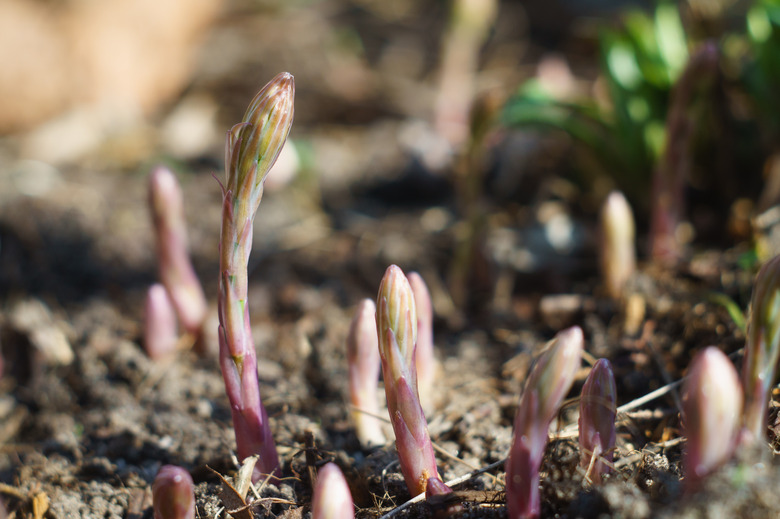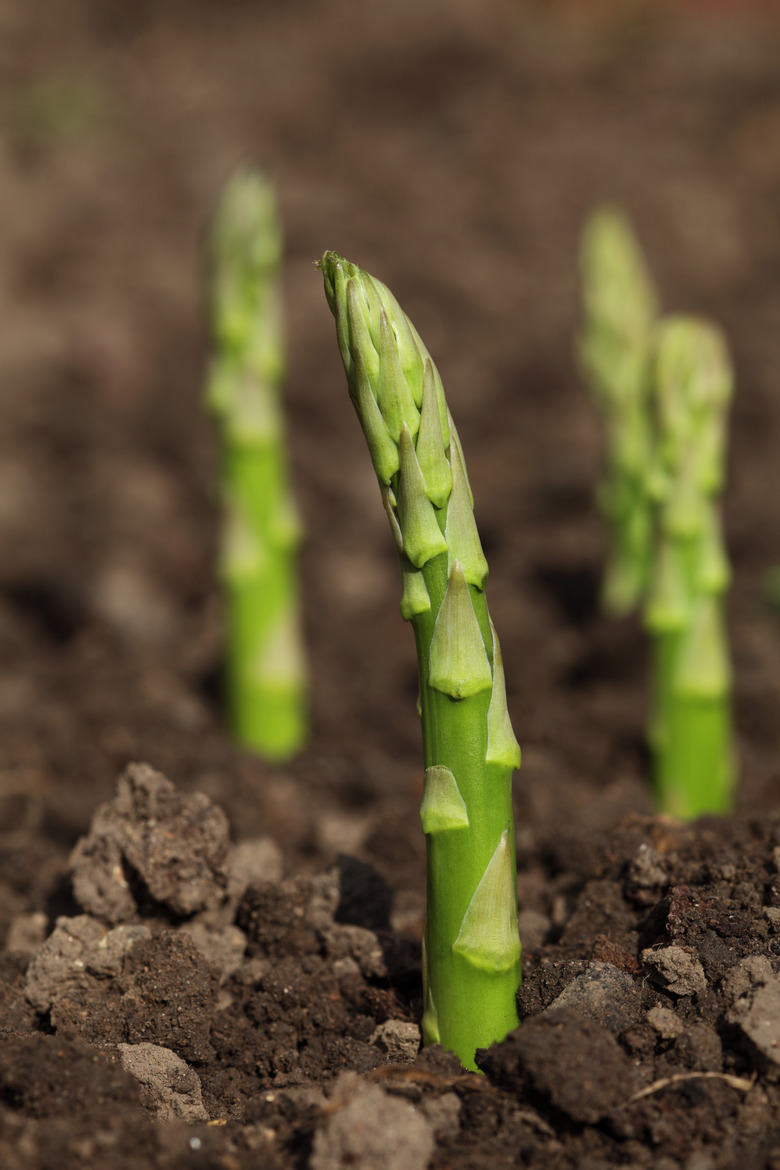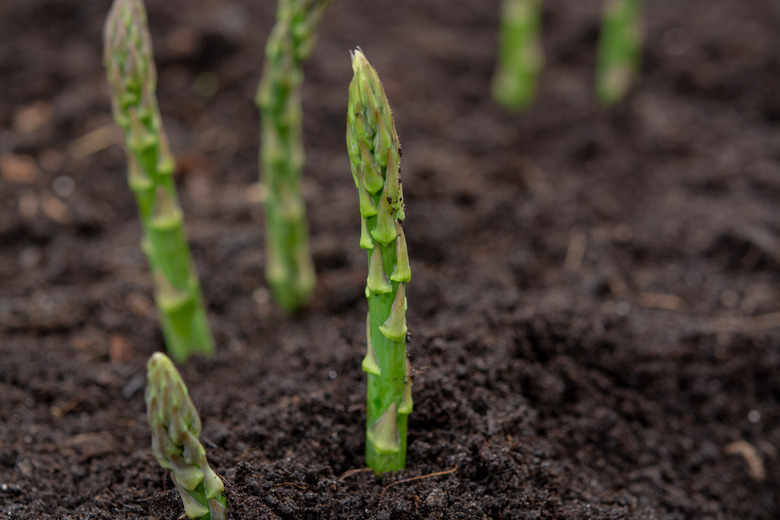How To Grow Asparagus
We may receive a commission on purchases made from links.
- Best uses for asparagus
- How to grow asparagus
- In what zone does asparagus grow best?
- When should you plant asparagus?
- Soil, sunlight and water recommendations for asparagus
- How to winterize asparagus
- How to harvest asparagus
- Common pests and other problems for asparagus
- Common diseases for asparagus
The best part of planting asparagus (Asparagus officinalis, USDA zones 3-10) at home is enjoying the crisp texture and fresh flavor of the vegetable to which store-bought asparagus spears can never measure up. While most people are familiar with the spears of asparagus seen in stores, they're surprised to learn these plants can grow 6 feet tall with soft, green fernlikefronds adorned with tiny, yellow flowers over the summer months.
Since asparagus is a perennial vegetable that lives an impressive 20 to 30 years, it can actually make a unique ornamental plant for your garden that will be one of the first plants to start sprouting its delicious, tender stalks every spring. While asparagus can be grown successfully throughout most of the United States, it does best in cooler areas with long winters.
Best Uses for Asparagus
Best Uses for Asparagus
It's said that Queen Nefertiti of ancient Egypt proclaimed asparagus to be "food of the gods"—and with good reason. Asparagus is not only delicious (crunchy, savory and the perfect side dish for a juicy steak), but it's also chock full of nutrients. Asparagus is a good source of fiber and Vitamins A, C and K, it's low in calories (provided you don't pan fry it in butter) and it is even said to lower your blood pressure. But beyond health benefits, asparagus is a surprisingly beautiful vegetable plant that can last a long time in your garden.
Since asparagus plants live for such a long time, it's important to put a lot of thought into your planting area. While you might imagine the small asparagus stalks only need a small amount of space, the deep asparagus roots and large foliage actually require a lot of space. You also need to plan to grow enough to have a vegetable side dish for everyone in your family. A good rule of thumb is to grow 10 plants per person. In other words, you'll need a large space in your vegetable garden to accommodate an asparagus patch—not a small pot on the back patio, as this plant requires some room to spread.
How to Grow Asparagus
How to Grow Asparagus
- Common Name: Asparagus
- Botanical Name: Asparagus officinalis
- When to Plant: Early spring
- USDA Zones: 3-10
- Sun Exposure: Full or partial sun
- Soil Type: Sandy is preferred but
can tolerate clay - When it's in Trouble: Foliage or
spears turning brown or yellow, curved spears, mushy or soft spots, too few spears - When it's Thriving: Grows strong,
straight spears in early spring followed by light green, lacy foliage in
early summer that will grow up to 4 to 6 feet tall
Starting Asparagus From Seed
Most people prefer to grow asparagus from crowns because it is quicker and easier, but it is drastically cheaper to start asparagus from seed. Start seeds indoors in late February or early March, soaking them for 24 hours before planting. Then, sow at a depth of 1/2 to 1 inch. Ideally, the soil temperature should be around 77 degrees Fahrenheit prior to sprouting and then lowered to between 60 and 70 degrees after the plants sprout.
Wait until the threat of frost has passed and the seedlings are large enough before transplanting outside. When the seedlings flower, weed out female plants since they produce fewer spears than male plants. You can do this by using a magnifying glass to look at the flowers when they first appear. Female flowers have a well-developed, three-lobed stamen and six undeveloped, small pistils, while male blossoms are longer and larger than the females and have six larger, well-developed stamens and one small, undeveloped pistil.
If you fail to catch any female plants at this stage, you'll notice they grow red berries in late summer, and you'll want to dispose of these when you notice them so they can be replaced with male plants later on. Most modern hybrid cultivars such as 'Jersey Giant' only produce male plants that yield a greater harvest.
In winter, trim the stalks down to the ground and be sure to mulch well to protect them from frost. In spring after the risk of frost has passed, transplant the small plants into a permanent bed if they're currently in a temporary location.
Starting Asparagus From Roots
The majority of people start growing asparagus plants by purchasing root bundles with a small stalk at the top. These are known as crowns and are available from nurseries only once a year in early spring. One-year-old crowns are preferable to older crowns, as they suffer less from transplant shock. Soak crowns in water for at least 20 minutes to prepare them for planting.
Before planting asparagus crowns, work 5-10-10 fertilizer into the soil using around 1 to 2 pounds per 100 square feet of soil. Next, dig a trench about 10 inches wide and 10 inches deep (or deeper for heirloom varietals).
Place the roots "head to toe," meaning with all the buds facing the same direction and their roots straight out behind them so that one plant's roots end at the next plant's bud. The practice of spreading out the roots like an octopus over a mound of soil in the trench is an outdated and unnecessary method. Cover the roots with soil until it meets the bottom of the stalk. Lay a top layer of mulch made from organic matter such as straw, pine needles or leaves 2 inches deep. These forms of mulch are preferable, as heavy mulch can impede the growth of asparagus spears through the soil.
When shoots begin to appear, rake back the mulch and add more soil or compost from the sides of the trench until the trench has been filled back up to ground level. Then, add more mulch.
In What Zone Does Asparagus Grow Best?
In What Zone Does Asparagus Grow Best?
While asparagus can grow in the majority of areas in the United States and lower Canada that do not have excessive summer heat, it does best in USDA plant hardiness zones 4 through 6. Gardeners in these zones have the most options when it comes to choosing varietals that will thrive in their region. For colder regions, try cultivars like Guelph Millennium that sprout late in order to avoid frost damage. In warmer areas, heat-tolerant cultivars like Apollo and UC-157 have an earlier growing season and sprout before the weather gets too hot.
If you live somewhere that doesn't have reliably freezing winter temperatures, withholding water during the winter months will bring about a similar dormancy period. Mulching is particularly important for plants in warmer areas, as it helps maintain constant soil moisture and temperature.
When Should You Plant Asparagus?
When Should You Plant Asparagus?
The best time to plant asparagus is early spring, as soon as the soil can be worked. This is the case whether you are growing from store-bought crowns or transplanting your homegrown asparagus seedlings. Mid-February through early March is ideal in most climates, but those in warmer regions should plant selections that sprout earlier and thus need to be planted earlier, and those in colder regions will do better with late-sprouting varietals that should be planted later. Always plant crowns as soon as possible after purchasing.
Soil, Sunlight and Water Recommendations for Asparagus
Soil, Sunlight and Water Recommendations for Asparagus
Asparagus prefers sandy soil, but it can survive in all but the heaviest clay soils. When planting in heavier soil, plant closer to the ground so the plants can push through the soil more easily. Similarly, while asparagus prefers neutral or slightly acidic soil, it can thrive in slightly alkaline soil as well.
Asparagus soil should have lots of nutrients and should stay moist with good drainage, so raised beds are a good option if you don't have naturally high-quality growing soil, but ensure your plants will have up to 2 feet of soil for their deep roots to grow. Make sure to select an area that gets plenty of sun and plan on putting the asparagus bed along the edge of the garden so it is not disturbed when you plant annual vegetables. Usually, it's best to keep asparagus on the north or east side of the garden so its tall foliage doesn't block your other plants from the sun. Do a thorough weeding before planting, as young asparagus does not do well with competition.
You'll need to dig up anywhere from 6 to 18 inches of soil depending on the variety and your soil type, with most modern species needing 6 to 8 inches of soil and older cultivar varieties like Martha Washington, Mary Washington and Waltham Washington requiring 12 to 18 inches of soil. Plants grown in heavier soil should be planted as close to the surface as recommended for the cultivar type.
While eight hours of full sunlight is preferable, asparagus can tolerate as little as six hours of partial sun as well. It is critical that you maintain a constant state of soil moisture without allowing excess moisture buildup that can cause root rot, particularly in the first year. A soaker hose or drip irrigation system can be useful in maintaining this water level. Mulching year-round will help retain moisture in the soil, protect early sprouts from frost and help prevent weeds from taking hold, which can choke out your asparagus plants. Be vigilant about weeding, particularly through the first and second year.
If you're looking to grow white asparagus, it's worth noting that it is not actually a unique variety but simply a result of preventing sunlight from reaching the sprouts by covering them in plastic or an extra layer of mulch, compost or soil. This prevents the development of chlorophyll in the stalks, leaving them to grow white, sweeter and more tender than standard green asparagus. If you're looking for purple varieties, these do come from specific cultivars, such as Purple Passion.
How to Winterize Asparagus
How to Winterize Asparagus
Asparagus foliage will turn brown and go dormant in the fall. When this happens, trim down the stalks and foliage. Cover the roots with a thick layer of mulch, as this will provide necessary protection against frost. Before new growth starts sprouting in spring, remove and destroy this winter mulch mix, as it could harbor disease and pest eggs that can ravage your plants when the weather warms. Lay a new layer of mulch after removing the winter layer.
How to Harvest Asparagus
How to Harvest Asparagus
One of the most challenging things about growing asparagus is having to wait until plants are at least three years old before harvesting so they can fully mature and establish deep roots that will keep them alive for decades. While it can be hard to wait, it will be worth your patience to have healthy plants that reliably provide you with delicious vegetables for decades.
Once your plant is finally ready, harvest asparagus slowly at the start of the season, starting every three days for the first few weeks and then increasing your asparagus harvest to as often as twice a day to keep up with the growth. Harvest spears when they are 5 to 7 inches tall, breaking them off with your fingers or cutting them to ground level with a sharp knife, making sure not to cut into neighboring stalks. Harvest season may last a few weeks all the way up to a few months depending on the health of your plants.
Stop harvesting asparagus in early summer after new spears stop growing wider than a pencil. At this point, leave the plants alone so they can build up their strength for next year's harvest. Fertilize after the harvest is complete.
Common Pests and Other Problems for Asparagus
Common Pests and Other Problems for Asparagus
If you notice your asparagus is growing bent, it's due to insect damage or because the stalk was damaged while cutting a neighboring spear. There are four major pests that can damage an asparagus crop.
The most common pest is the asparagus beetle, which chews on spears in spring and destroys foliage during summer. The common asparagus beetle is recognizable by its blue head and blue wings with yellow or white spots. The spotted asparagus beetle is a reddish-orange color with black spots. Eggs will be black, yellow or light green and laid in rows on young asparagus shoots. Larvae may be dark olive, light gray or brown.
The best way to control asparagus beetles is to brush the eggs away and hand pick the larvae and beetles. Really bad infestations may require an insecticidal soap. This soap can also help reduce aphids and light-colored thrips. Aphids can often be seen on asparagus tips and can also be controlled with ladybugs. Light-colored thrips can be identified by light spots left behind after shaking asparagus foliage over black paper and can usually be removed easily with heavy rain or a high-pressure spray hose.
A final asparagus pest you may notice is the asparagus miner, which makes tunnels through the stalks. Certain cultivars such as Jersey Giant are naturally resistant to these pests, but there are no effective pesticides for asparagus miners, so removing dead fall foliage before spring growth begins is the most effective prevention method.
If young asparagus sprouts are turning brown, withering or becoming soft, they may have frost damage. Cover spears with mulch or newspapers until the threat of frost is over.
Common Diseases for Asparagus
Common Diseases for Asparagus
The three main diseases seen in asparagus are fusarium, crown rot and rust disease. Fusarium reduces yields and makes the plants suffer from a much shorter life span. It can be identified by wilted spears that are small and brownish. Crown rot is a fungus that, as the name implies, causes rotting tissue between the stem and roots that will eventually kill the plants. Rust is usually a problem in areas with high humidity and warm temperatures and can be identified by small orange patches on the spears and branches.
Many cultivars such as Jersey Knight are resistant to these diseases, so you can make things much easier for yourself by choosing these selections. If you chose nonresistant types and notice these problems, you'll need to completely remove and dispose of your existing asparagus plants. Avoid growing asparagus in the same place for at least eight years and grow any new plants far away from the contaminated soil next year.
References
- The Old Farmer's Almanac: Growing Asparagus
- Growables: Asparagus officinalis – Cultivars
- Gardener's Supply Company: How to Grow Asparagus
- Seed to Fork: Growing Asparagus From Seed
- Bonnie Plants: Growing Asparagus
- University of Massachusetts Amherst: Asparagus Miner
- Gardening Know How: What's The Difference Between Male And Female Asparagus Plants
- Burpee: All About Asparagus
- Old World Garden Farms: How To Grow Asparagus – The Secrets To Plant & Grow A Delicious Crop!
- Growers Solution: Asparagus Jersey Giant Bare Root – 2 Yr Old
- Harvest to Table: Asparagus Growing Problem Troubleshooting
- Cook's Illustrated: White Asparagus vs. Green
- Mobile Cuisine: Asparagus Fun Facts


